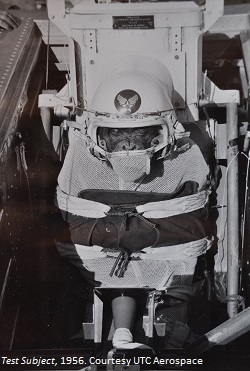Dublin Core
Title
Description
Imagine you are a fighter pilot needing to escape your plane when something goes wrong. Your life depends on the work of scientists who – more than sixty years ago – filled the Utah desert air with sonic booms and flying monkeys.
Being a fighter pilot has long been a dangerous job. But starting in 1954, a dedicated team of aerospace scientists worked on an isolated plateau in the heart of the Utah desert, developing technology and running tests that would save the lives of American fighter pilots.
In the early days of flight, pilots made emergency escapes by crawling out of the cockpit, jumping off the airplane wing, and pulling their parachute on the way down. After World War II, jets began flying at speeds above Mach 1 – faster than the speed of sound – and the old safety equipment wasn’t good enough anymore. In fact, between 1949 and 1956, 80% of pilots who ejected from their planes were injured or killed.
Responding to these tragic deaths, the United States Air Force searched for a site to test ejection seats, parachutes, and the effects of supersonic flight on the human body. They found the ideal location atop Hurricane Mesa above Virgin, Utah, where in 1954 they built the Supersonic Military Air Research Track – called Project SMART. This test facility consisted of a 12,000-foot-long track, a rocket sled, and a pusher loaded with live rockets to hurtle the sled down the test track at supersonic speeds.
Researchers then turned to the problem of how to fling a human out of the rocket sled without death. To test the effects of high-speed flights and ejections, they strapped a crash-test dummy wearing a parachute to the rocket sled. These dummies – the most famous of whom was named Hurricane Sam – recorded whole-body movements and transmitted data via telemetry during the simulations. These dummies came to be known as “Flying Monkeys,” which was a nod to the live monkeys, pigs, and bears initially used as test subjects. For six years, these data-gathering dummies parachuted 1500-feet down to the valley floor after being ejected from the rocket sled on top of Hurricane Mesa.
Project SMART closed in 1961, after 334 tests that helped design safer ejection systems for American pilots.
Creator
Jean Krause and Linda Collet for The Pocketville Project © 2017
Source
_______________
See Paul W. Reeve, “A Dummy Called ‘Hurricane Sam’ Gave Pilots a Safety Edge,” History Blazer, Utah State Historical Society, March 1995, accessed at https://heritage.utah.gov/history/uhg-dummy-called-hurricane-sam; Coleman Engineering Company, Inc., “Supersonic Survival,” 1955, Periscope Film, accessed at https://www.youtube.com/watch?v=RZtdGEbqek4; and The Pocketville Project exhibition file for “Flying Monkeys, Fighter Pilots, and Fence Posts,” curated by Jean Krause and Linda Collet, 2017. Note that remnants of Project SMART can still be seen lining roads and property boundaries all over Virgin, Utah where residents recycled spent rocket tubes as fence posts. Next time you’re driving through Washington County, keep an eye out for these little pieces of history and remember the Flying Monkeys and the researchers of Hurricane Mesa who made flying planes a whole lot safer.

